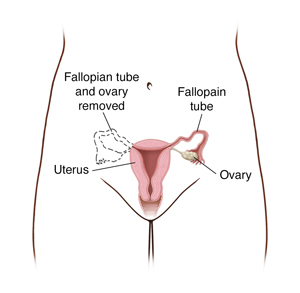Understanding Unilateral Salpingo-Oophorectomy
A unilateral salpingo-oophorectomy is a type of surgery. A surgeon removes one ovary and one fallopian tube from your pelvis. The ovaries are located on either side of the uterus. They store your eggs (ova). They also make the hormone estrogen. The fallopian tubes link the ovaries to the uterus. They carry the ova to the uterus.
You can still have children after you have this procedure as long as you have one ovary and fallopian tube left.

How to say it
sal-PING-goh-oh-oh-fuh-REK-tuh-mee
Why unilateral salpingo-oophorectomy is done
This procedure may be done if you have an ovarian cyst, an abscess, or certain types of cancer in an ovary or fallopian tube. Or you may have it to lower your risk for cancer in these parts of the body. If you have a high chance of getting this cancer, you may be advised to have a bilateral salpingo-oophorectomy. For that procedure, both ovaries and the fallopian tubes are removed.
This procedure may also be done if you have your uterus removed. This is called a hysterectomy. Other health problems may call for taking out an ovary and fallopian tube at the same time.
How unilateral salpingo-oophorectomy is done
You will check into a hospital. You may need to spend a few days there after this surgery. During the procedure:
-
You are given medicine to make you fall asleep. You won’t feel any pain.
-
The surgeon makes a cut (incision) in your belly to reach your reproductive organs.
-
The surgeon removes the ovary and fallopian tube.
-
The surgeon then ties and stitches up all open wounds. The cut in the abdomen is closed up.
Risks of unilateral salpingo-oophorectomy
Online Medical Reviewer:
Irina Burd MD PhD
Online Medical Reviewer:
Marianne Fraser MSN RN
Online Medical Reviewer:
Tennille Dozier RN BSN RDMS
Date Last Reviewed:
3/1/2025
© 2000-2025 The StayWell Company, LLC. All rights reserved. This information is not intended as a substitute for professional medical care. Always follow your healthcare professional's instructions.